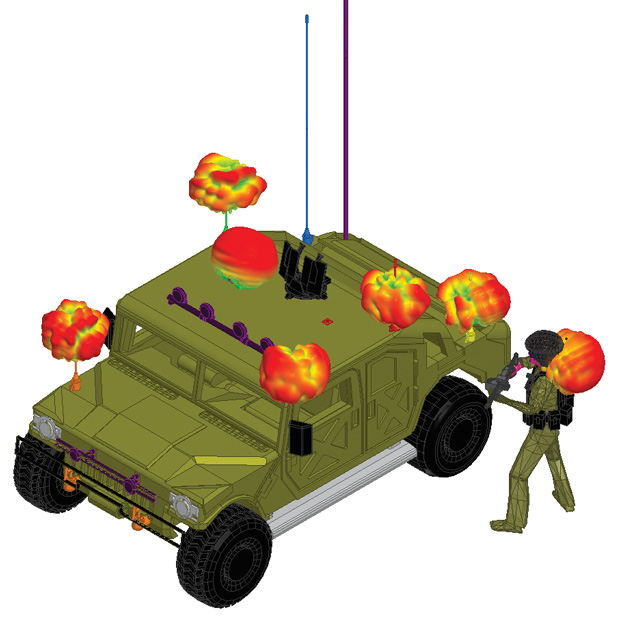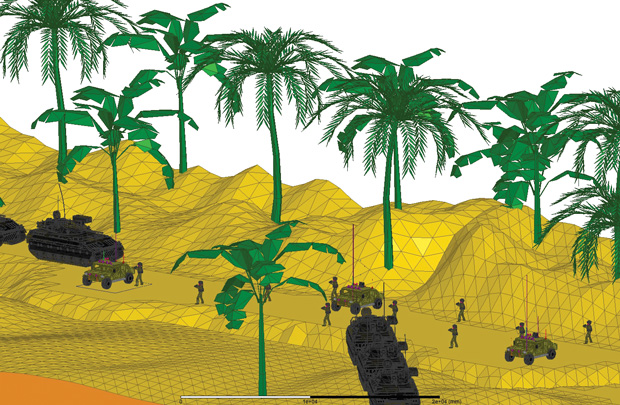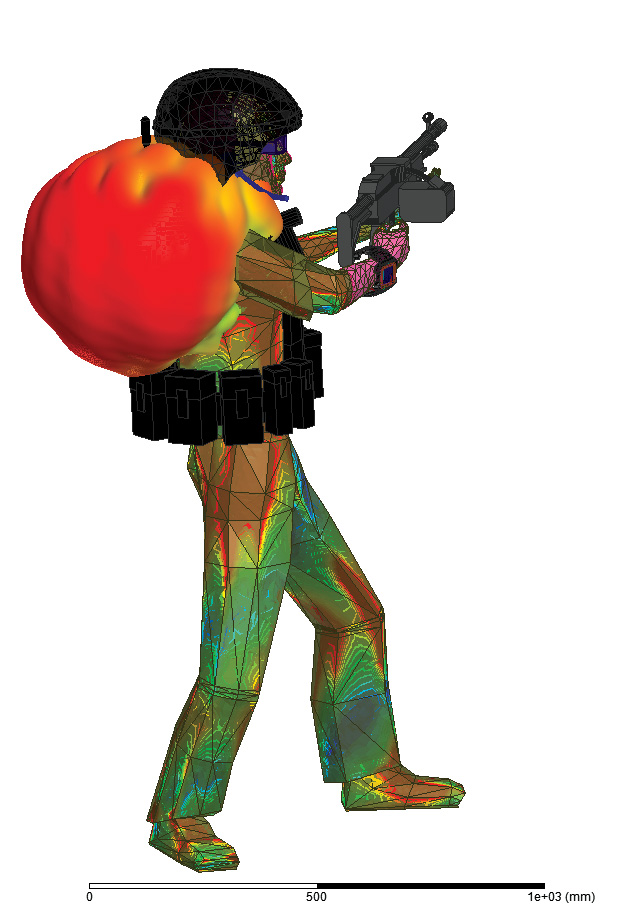
One of the big challenges is designing antenna technology that allows soldier and vehicle radios to operate in concert without causing radio frequency interference. Image courtesy of ANSYS.
Latest News
September 1, 2016
 ANSYS EMIT was used to model complete scenes to detect RFI and the root cause and well as to explore suitable measures for mitigating interference. Image courtesy of ANSYS.
ANSYS EMIT was used to model complete scenes to detect RFI and the root cause and well as to explore suitable measures for mitigating interference. Image courtesy of ANSYS.Modern-day soldiers are entering the battlefield not only with weaponry, but also with an electronics command and control center built on the sensors, antennas and communications capabilities of the Internet of Things (IoT).
The combination of multiple radios, wearables like smartwatches and glasses, biosensors, GPS equipment and communications devices are just some of the gear arming soldiers with life-saving information and creating unprecedented visibility into their surroundings. These technology-enhanced fighters benefit from constant contact with their command units and troops, gain more situational awareness, and are able to collaborate on mission next-steps all with the goal of striking the best defense.“Our current and future soldiers are only as good as the communications that’s shared with them,” says Jean Louis DeGay, of the U.S. Army Natick Soldier Research, Development and Engineering Center (NSRDEC), who likens today’s soldiers as “F-16s on legs” because they have access to comparable capabilities found on aircraft or other military platforms. “The sharing of the information wins the fight, not the biggest or best bullet. We are looking at a soldier as a communications intelligence platform, not just a person with a weapon system.”
DeGay says work is underway on new intelligent body gear that among other things includes on-board computers that allow soldiers to chat online during missions and to tie into key defense networks to tap into intelligence. Soldiers will also be able to share mission data, watch mission-related video clips, and even exchange surveillance intelligence with nearby military vehicles, aircraft or other troops. The onboard computing power will also monitor the soldier’s physiological status via biosensors to provide a clear picture of their vitals and their performance, alerting nearby medics to potential problems.
Of course, the key to this vision of a connected soldier is the connectivity itself. Yet, there are numerous communications and networking obstacles related to the harshness of the battlefield and the density of the radio frequency environment. Hundreds of control, communications, computers and surveillance systems, buoyed by thousands of antennas, sensors and RF (radio frequency) circuits, are vying for RF signals within a limited RF spectrum. The sheer volume of communications presents a daunting challenge for each unit to operate simultaneously without bumping up against other nearby systems, according to Robert Harwood, global industry director for Aerospace and Defense at ANSYS, which is actively exploring how simulation and modeling can help mitigate radio frequency interference (RFI) on the battlefield.
“As we go down the path of the connected soldier, the design problem becomes a lot more complicated and the design space much harder because there are so many more sensors and not just radar or frequency,” he explains. “All of a sudden, everything is connected and you have many proliferating systems.”
A Focus on Antenna Design
ANSYS put its simulation muscle to work on antenna design, as a way to come up with innovative shapes that could accommodate the proliferation and mobility of modules as well as to address durability in what is often an extreme and unforgiving landscape. In addition, because the connected soldier has to co-exist with other assets and equipment on the battlefield—other troops, tanks and unmanned air systems—and oftentimes in the presence of hostile forces, simulation is the most effective way to test the interactions and explore different antenna designs to mitigate potential RFI, Harwood says.
 Wearables, including smart glasses and watches, are among the devices that require antennas
Wearables, including smart glasses and watches, are among the devices that require antennasthat will aid in soldier communications. Image courtesy of ANSYS.
“Electromagnetics is not a new problem, but it just got more complicated,” he says. “There are a whole number of antennas on a given soldier and if you think of how many scenarios that person is operating within—there could be a Humvee driving past or a drone flying overhead—it’s difficult to assess how that will perform. In a virtual environment, you can run through the design trade off space very quickly. To do that physically would be very time consuming, impractical and costly.”
For the exercise, the ANSYS team leveraged the High Frequency Electromagnetic Field Simulation (HFSS) tool to model the various communication systems and antennas on the soldier, including smartwatches, smartglasses and a UHF manpack operating at 300MHz, which serves as the link back to nearby military vehicles. On the vehicle side, the radios were modeled to operate over multiple bands from low VHF to L-band.
ANSYS EMIT, which simulates RFI in complex environments, worked in tandem with ANSYS HFSS to predict the effects of RFI in the simulated battlefield’s multi-antenna, multi-transmitter/receiver environment. By modeling the complete scene, EMIT computed the interactions between the various systems and found that some of the vehicle radios caused the soldier to lose contact with the nearby Humvee. The combined analysis tools suggested several root causes of the RFI in addition to the associated path of interfering signals. With this simulation-driven workflow, ANSYS was able to demonstrate how engineers could obtain diagnostic information leading to filtering, frequency planning and other operational design decisions that in turn would ensure that all antennas and communications systems could co-exist and perform as required.
 One of the big challenges is designing antenna technology that allows soldier and vehicle radios to operate in concert without causing radio frequency interference. Image courtesy of ANSYS.
One of the big challenges is designing antenna technology that allows soldier and vehicle radios to operate in concert without causing radio frequency interference. Image courtesy of ANSYS.The ANSYS team went even further, using simulation to explore communication connectivity failure possibilities in the event a bomb detonated or a communications module was hit, Harwood says. Using ANSYS Explicit Dynamics, the team examined the response of an antenna on a Humvee in simulation, to determine its potential for survival upon impact. For the simulation, the group worked using an impact velocity of slightly over 100 m/s, which is on the lower range of the typical fragment velocity resulting from a nearby bomb explosion. In this case, the simulation found that the antenna would be severely deformed, but not necessarily broken.
Confronting Complex Challenges
ANSYS isn’t the only simulation platform being tapped for the design of the connected soldier. Altair’s FEKO electromagnetic analysis software is being used by Canada’s Department of National Defense to explore a variety of issues related to antenna design for wearable radio transmitters worn by military personnel there. FEKO is being used to explore how to design an antenna that can cover multiple software radios in a single unit; operate across a span of frequencies, from low megahertz to high gigahertz; and is embedded into the soldier’s clothing or body armor. FEKO is also being used to explore electromagnetic interference (EMI) between antennas when operating in scenarios where there are multiple, uniformed personnel in close proximity such as soldiers in formation, says C.J. Reddy, vice president, business development electromagnetics, Americas at Altair.
 Simulation was used to investigate the electromagnetic fields generated from the various antennas on the soldier and highlight possible RFI between them. Image courtesy of ANSYS.
Simulation was used to investigate the electromagnetic fields generated from the various antennas on the soldier and highlight possible RFI between them. Image courtesy of ANSYS.Simulation becomes a critical part of the design process, Reddy contends, given the complexity of the antenna design problem in this environment. “These are not back of the envelope calculations,” he says. “You need realistic calculations and you need CAD models of the human body on which to do numerical analysis. When you’re looking at electromagnetics problems, it’s hard to do with paper and pen.”
When faced with complex design challenges like the connected soldier, ANSYS’ Harwood maintains a full simulation suite, not just individual analysis tools, is critical for achieving the best results. “With simulation, it’s not a one-sized-fits-all approach to the different phenomena,” he says. “To solve these complicated problems, you need a comprehensive simulation environment.”
More Info
Subscribe to our FREE magazine, FREE email newsletters or both!
Latest News
About the Author
Beth Stackpole is a contributing editor to Digital Engineering. Send e-mail about this article to [email protected].
Follow DE





